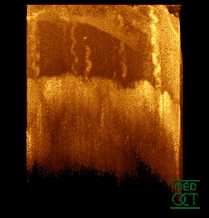Epidermis is the outermost layer of the skin. It forms the waterproof, protective wrap over the body's surface and is made up of stratified squamous epithelium with an underlying basal lamina.
Components
The epidermis contains no blood vessels, and is nourished by diffusion from the dermis. The main type or the four principal types of cells which make up the epidermis are keratinocytes, melanocytes, Langerhans cells and Merkels cells. It is a keratinized stratified squamous epithelium.
Layers
The epidermis is divided into several layers where cells are formed through mitosis at the innermost layers. They move up the strata changing shape and composition as they differentiate and become filled with keratin. They eventually reach the top layer called stratum corneum and become sloughed off, or desquamated. This process is called keratinization and takes place within weeks. The outermost layer of epidermis consists of 25 to 30 layers of dead cells.
Sublayers
Epidermis is divided into the following 5 sublayers or strata, listed from the superficial to deep:
- Stratum corneum
- Stratum lucidum (not present in thin skin, only thick, hairless skin of palms & soles)
- Stratum granulosum
- Stratum spinosum
- Stratum germinativum (also called "stratum basale")
It is the deepest layer of the skin specifically the epidermis. the anatomical structure of it is composed of a single row of cuboidal of columnar keratinocytes.
Mnemonics used for remembering the layers of the skin (using "stratum basale" instead of "stratum germinativum"):
- "Corn Lovers Grow Several Bales" (from superficial to deep)
- "Before Signing, Get Legal Counsel" (from deep to superficial)
Additional images
http://en.wikipedia.org/wiki/Epidermis_(skin)








No comments:
Post a Comment